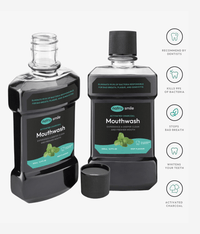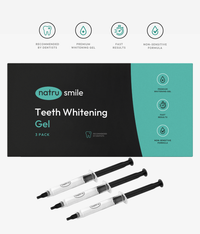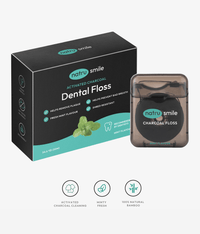
All products are certified by dental expert Dr. Greg Grillo
Did you know that cancers in the mouth and throat can wreak havoc on your overall health and make it difficult to eat, speak, and breathe? These malignant growths, known as oral cavity and oropharyngeal cancers, can develop in various areas, such as the lips, tongue, gums, and floor of the mouth.
That's why early detection is crucial! It can improve your chances of successful treatment and a better prognosis, allowing you to maintain a good quality of life.
Let’s take a closer look at oropharyngeal cancers.
Risk Factors And Symptoms
Oral cavity and oropharyngeal cancers are serious medical conditions that can have a significant impact on a person's health and wellbeing. It is important to be aware of the risk factors and symptoms associated with these cancers in order to detect and treat them as early as possible.
Tobacco use is one of the leading risk factors for oral cavity and oropharyngeal cancers. Smoking cigarettes, cigars, pipes, and using smokeless tobacco can all increase the risk of developing these cancers. Heavy alcohol consumption is another significant risk factor, and the risk is even higher when combined with tobacco use. Human papillomavirus (HPV) infection is also a known risk factor, particularly for oropharyngeal cancer.
Other risk factors include prolonged sun exposure, which can lead to lip cancer, poor oral hygiene, and a diet low in fruits and vegetables. These risk factors can increase the likelihood of developing these cancers, but they do not guarantee that a person will develop them.
Symptoms of oral cavity and oropharyngeal cancers can vary depending on the location and severity of the cancer. Some common symptoms include persistent mouth pain or soreness, a lump or thickening in the cheek, a white or red patch on the gums, tongue, or lining of the mouth, a sore throat or persistent feeling that something is caught in the throat, difficulty chewing, swallowing, or moving the tongue or jaw, swelling in the jaw or neck, and unexplained weight loss.
If you experience any of these symptoms, it is important to seek medical attention right away. Early detection and treatment can improve outcomes and increase the chances of a full recovery. Regular dental check-ups can also help detect any signs of oral cavity and oropharyngeal cancers.
Oral Cavity: Structure And Function
The oral cavity is a complex, multifunctional structure that consists of various components, including the lips, cheeks, gums, teeth, tongue, and hard and soft palate. It plays a vital role in the initial stages of digestion, as it's responsible for breaking down food, forming a bolus, and swallowing. Moreover, it's crucial for communication, allowing us to articulate speech and express emotions.
Mapping The Oral Cavity
The oral cavity is an important structure in the human body responsible for a wide range of functions, including speech, taste, and digestion. To better understand the anatomy of the oral cavity, it can be divided into several regions.
The vestibule, which is the area between the teeth, lips, and cheeks, serves as the entrance to the oral cavity proper. It acts as a buffer zone between the external environment and the oral cavity, protecting it from harmful substances, temperature changes, and mechanical trauma.
The oral cavity proper is the space behind the teeth, where food is chewed and mixed with saliva for digestion. This area houses the tongue, which is a muscular organ covered in specialized taste buds that aid in mastication, swallowing, and speech. The tongue is essential for taste sensation, and it also helps to shape food into a bolus that can be swallowed.
The hard palate is the anterior, bony part of the roof of the mouth that separates the oral and nasal cavities. It is an important structure for speech production and helps to direct food towards the back of the mouth for swallowing. The soft palate, on the other hand, is the posterior, muscular part of the roof of the mouth that closes off the nasal passages during swallowing to prevent food from entering the nasal cavity.
Classifying The Oral Cavity
The oral cavity can be classified into various types based on its morphology, location, and function. For example, the human oral cavity can be categorized into primary and secondary types.
The primary oral cavity comprises the lips, cheeks, teeth, and gums, which are involved in the initial stages of food processing and the formation of bolus.
The secondary oral cavity includes the hard and soft palate, tongue, and salivary glands that play essential roles in digestion, taste perception, and the production of saliva.
What Conditions And Disorders Can Affect The Oral Cavity?
A variety of conditions and disorders can affect the oral cavity, ranging from common to severe. Understanding these issues can help you identify symptoms early on and seek appropriate treatment. The following conditions are among the most prevalent affecting the oral cavity:
Bad Breath (Halitosis)
Bad breath, or halitosis, is a common oral health issue that can be caused by:
- Bacteria buildup in the mouth
- Poor oral hygiene
- Dry mouth
- Gum disease
- Consuming certain foods (e.g., garlic, onions)
- Smoking or tobacco use
- Other underlying health conditions (e.g., sinus infections, diabetes)
To prevent bad breath, it's essential to practice good oral hygiene, drink plenty of water, and schedule regular dental check-ups.
Cleft Lip And Palate
A cleft lip and palate are congenital abnormalities where the lip and/or roof of the mouth fail to close properly during fetal development. These conditions can lead to:
- Feeding difficulties
- Speech problems
- Ear infections
- Dental issues
- Emotional challenges
Treatment for cleft lip and palate typically involves a combination of surgery, dental care, and speech therapy.
Cold Sores And Other Ulcers
Cold Sores
Cold sores, also known as fever blisters, are caused by the herpes simplex virus (HSV). They typically appear as small, painful blisters around the lips, and can be triggered by:
- Stress
- Fatigue
- Illness
- Hormonal changes
- Sun exposure
Antiviral medications can help reduce the duration and severity of cold sores.
Aphthous Ulcers
Aphthous ulcers, or canker sores, are small, painful lesions that develop inside the mouth. They can be caused by:
- Stress
- Hormonal fluctuations
- Food sensitivities
- Vitamin deficiencies
Aphthous ulcers usually heal on their own within a week or two, but over-the-counter medications can help alleviate pain and inflammation.
Dry Mouth (Xerostomia)
Dry mouth, or xerostomia, is a condition where the salivary glands produce insufficient saliva, which can lead to:
- Discomfort or difficulty swallowing
- Altered taste sensations
- Increased risk of dental decay and gum disease
- Bad breath
Causes of dry mouth include dehydration, certain medications, tobacco use, and medical conditions like Sjögren's syndrome. To alleviate dry mouth symptoms, drink water regularly, use a humidifier, and avoid tobacco and alcohol.
Infections
Various infections can affect the oral cavity, including:
Thrush
Thrush is a fungal infection caused by the Candida species. It appears as white, creamy patches on the tongue, inner cheeks, or roof of the mouth. Risk factors for thrush include:
- Weakened immune system
- Diabetes
- Antibiotic use
- Poor oral hygiene
- Denture use
Treatment for thrush typically involves antifungal medications.
Bacterial Infections
Bacterial infections, like periodontitis, can damage the gums and supporting structures of the teeth. Symptoms include:
- Red, swollen gums
- Bleeding gums
- Bad breath
- Loose teeth
- Receding gums
To prevent and treat bacterial infections, maintain good oral hygiene, visit your dentist regularly, and quit smoking.
Oral Cancer
Oral cancer can develop in any part of the oral cavity, such as the lips, tongue, cheeks, floor of the mouth, hard and soft palate, and oropharynx. Key risk factors for oral cancer include:
- Tobacco use: Smoking cigarettes, cigars, or pipes, and using smokeless tobacco products significantly increase the risk of oral cancer.
- Alcohol consumption: Excessive alcohol intake is another major risk factor, and the combined use of tobacco and alcohol further multiplies the risk.
- Human papillomavirus (HPV) infection: Certain strains of HPV, particularly HPV-16, have been linked to oropharyngeal cancers.
- Prolonged sun exposure: Excessive sun exposure increases the risk of lip cancer.
Signs And Symptoms Of Oral Cancer
- Persistent sores or ulcers in the mouth that do not heal
- Pain or difficulty swallowing
- Unexplained weight loss
- Loose teeth or dentures that no longer fit
- White or red patches inside the mouth
- Persistent bad breath
Tongue Issues
Problems with the tongue can impact taste, speech, and overall oral comfort. Common tongue issues include:
Geographic Tongue
Geographic tongue is a benign condition characterized by smooth, reddish patches on the tongue's surface, often surrounded by a slightly raised white border. These patches can change shape and location over time.
Fissured Tongue
A fissured tongue has deep grooves or fissures on its surface. These grooves can trap food particles and bacteria, increasing the risk of bad breath and oral infections.
Tongue-Tie
Tongue-tie, or ankyloglossia, is a congenital condition where the frenulum (the tissue connecting the tongue's underside to the floor of the mouth) is too short, limiting tongue movement. This can affect speech, eating, and oral hygiene.
Trauma Or Injury
Injuries to the oral cavity can result from various incidents, including:
- Sports-related accidents
- Falls
- Automobile accidents
- Physical altercations
- Biting down on hard foods
These injuries may require dental or surgical intervention, such as root canal treatment, tooth extraction, or reconstructive surgery.
Problems With Your Teeth
Tooth-related issues can cause pain, discomfort, and affect oral function. Common problems include:
- Cavities: Tooth decay caused by bacterial plaque buildup and poor oral hygiene
- Tooth fractures: Cracked or broken teeth due to trauma or biting on hard objects
- Tooth sensitivity: Pain or discomfort when consuming hot, cold, sweet, or acidic foods and beverages
Problems With The Gums
Gum problems can range from mild inflammation to severe infection and tissue destruction. Common gum issues include:
- Gingivitis: Mild inflammation of the gums, often caused by plaque buildup
- Periodontitis: Severe gum infection that can damage the jawbone and lead to tooth loss
Speech Problems
Speech problems can arise from a variety of factors affecting the oral cavity and its function, such as:
- Structural abnormalities: Cleft lip or palate, tongue-tie, or dental malocclusions
- Muscle weakness: Inadequate strength or coordination of the oral muscles
- Neurological issues: Stroke, brain injury, or neurological disorders impacting speech production
Are Oral Health And Pregnancy Linked In Any Way?
Yes, oral health and pregnancy are linked in several ways. Poor oral health during pregnancy can lead to several problems such as gingivitis, periodontitis, preterm birth, low birth weight, and preeclampsia. This is why it is important for pregnant women to take care of their oral health by practicing good oral hygiene, eating a balanced diet, and visiting the dentist regularly.
How Are Oral Health And Overall Well-Being Linked?
Oral health and overall well-being are closely linked. Poor oral health can lead to several health problems such as heart disease, stroke, diabetes, and respiratory infections. On the other hand, good oral health can improve one's quality of life by boosting self-esteem, allowing for proper nutrition and speech, and preventing pain and discomfort. Regular dental check-ups, brushing and flossing, and a healthy diet can help maintain good oral health and overall well-being.
What Is The Link Between Diabetes And Oral Health?
Diabetes and oral health are interrelated. High blood sugar levels in people with diabetes can lead to several oral health problems such as gum disease, dry mouth, fungal infections, and slow healing of oral tissues. Similarly, poor oral health can also affect diabetes control by increasing blood sugar levels. It is important for people with diabetes to practice good oral hygiene, visit the dentist regularly, and maintain healthy blood sugar levels to prevent oral health problems.
Are Stress And Oral Health Interrelated?
Yes, stress and oral health are interrelated. Stress can lead to several oral health problems such as teeth grinding, canker sores, gum disease, and dry mouth. These problems can then lead to further stress and anxiety, creating a vicious cycle. It is important to manage stress through relaxation techniques such as meditation, deep breathing, and exercise to prevent these oral health problems.
The Bottom Line
The oral cavity is an integral part of our overall health and well-being. Maintaining good oral health is essential not only for the functionality of the oral cavity but also for preventing various oral conditions and disorders. To ensure optimal oral health, it's crucial to practice good oral hygiene, attend regular dental check-ups, and address any potential issues as soon as they arise.












